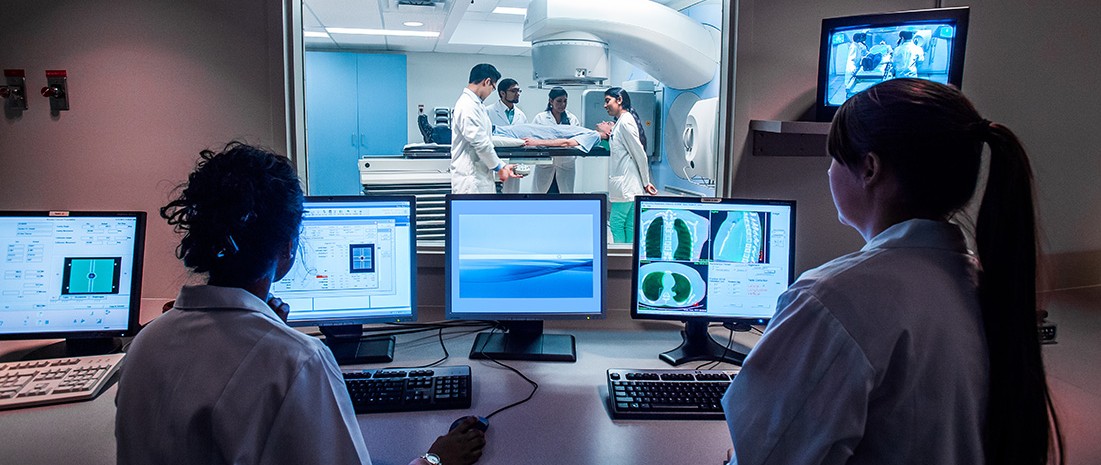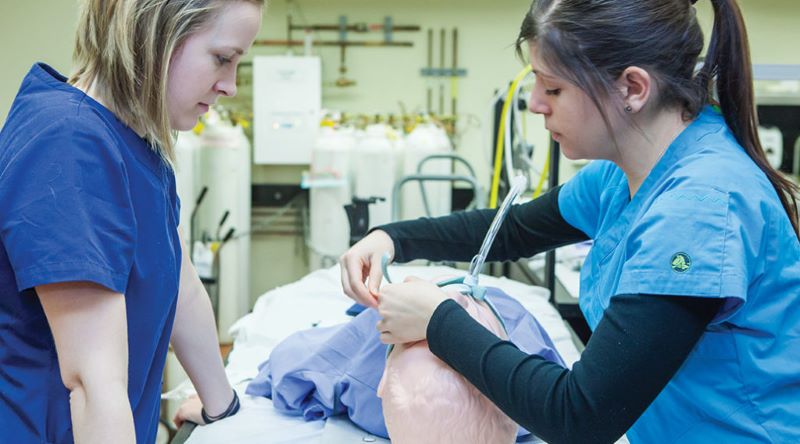Focused on providing learners with realistic and responsive educational experiences, Michener is home to a unique and comprehensive suite of simulation environments. From the Centre for Advancement of Simulation in Education (CASE) to the Objective Structured Clinical Examination (OSCE) suites, Michener students and participants from other healthcare organizations use simulation environments as an important part of education and professional development.
“Just as pilots have to spend a certain amount of time in a flight simulator each year, an increasing number of healthcare professionals are relying on simulation-based training.”

Jordan Holmes runs the simulation centre at Michener, a series of environments that feature objective controls rooms, audio-video recording equipment and in-depth debriefing capabilities. As the coordinator for CASE and OSCE suites, he explains that simulation-based training enhances learning by providing a heightened clinical experience within a controlled environment. “We can expose students to things they may or may not see in their clinical rotations and structure it with in-depth debriefing in every scenario. Students are getting really in-depth, meaningful learning coming away from it.”
A state-of-the-art, multi-modality simulation centre, CASE comes equipped with 20,000 square feet of simulation space and integrated audio-video equipment for objective review and evaluation. Housed within CASE are 24 OSCE suites, specifically designed for testing and assessment.
According to Jordan, as organizations and healthcare regulatory bodies adopt the OSCE evaluation method, Michener is staying ahead of the curve, facilitating complex simulation scenarios and evaluation for both its own programs and for external partners such as the Ontario College of Family Physicians and the Centre for the Evaluation of Health Professionals Educated Abroad. “More and more organizations are using OSCEs to do an assessment of healthcare professionals before they can enter into clinical practice,” Jordan says. “A lot have been coming to Michener’s CASE environments for this reason.”
Over the last few of years, the usage of CASE for simulations and assessments by Michener programs and external clients has grown significantly. “This really highlights the growing acceptance and utilization of simulation-based competency assessment in healthcare,” Jordan says. “Just as pilots have to spend a certain amount of time in a flight simulator each year, an increasing number of healthcare professionals are relying on simulation-based training.”
“It means having the ability to practice challenging situations without negative consequences. That’s the real gift of simulation.”

The OSCE suites have huge advantages for not just assessment, but also for reflective learning in simulation settings, according to Jordan. “The simulations themselves are excellent for hands-on experiential learning. But it’s really the debriefing and being able to think about what the students just did – that’s where the extra level of learning happens.”
Fiona Cherryman, Chair of Critical Care at Michener, agrees. Using the example of a third-year Respiratory Therapy paediatric simulation that uses greater realism, she says, “We’ve got a large trauma case where we’re breaking it up into smaller pieces and debriefing it along the way.” The OSCE suites are used to record the simulation in practice, which then facilitates the debriefing process and aids review and reflection.
According to Fiona, it’s a useful process to fully prepare students for intense, complex scenarios. “It’s about going deeper,” she says. Particularly when training for difficult or high-risk situations, “simulation allows you to take time out and debrief fully in the moment. That is not always possible in the clinical setting.”
That level of practice simulation and objective review provides is a huge assurance to patient safety, says Bonnie Sands, a Radiological Technology faculty at Michener. In a first-year Medical Radiation Sciences patient care course, Michener’s OSCE technology is used to video recorded students transferring a patient (acted out by a fellow student) from a stretcher onto an examination table. It is a rudimentary task-based simulation exercise, says Bonnie, but “we wanted them to make mistakes, because after making mistakes they had a lot of key learning.”
For Bonnie, creating a safe environment to make mistakes is fundamental to teaching the importance of safety and patient care. “After doing and recording the task, they repeated the transfer under the direction of the lab instructor so they knew how it was supposed to be done properly.”
Simulation teaches not only the technical skills, but also the skills to operate in a collaborative, interprofessional environment. When simulating these cases within a controlled environment such as CASE, Fiona observes, “It means having the ability to practice challenging situations without negative consequences. That’s the real gift of simulation.”
Did you know:
- CASE features 24 OSCE suites for testing and assessment
- Several rooms offer built in recording equipment configured to the CAE LearningSpace recording and debriefing system, as well as portable AV equipment available for custom scenarios
- Examiner corridors behind OSCE suites have one-way glass and control panels for viewing and monitoring
- Separate rooms to accommodate standardized patients, examiners, candidates, administration and AV personnel
- CASE offers a variety of simulation facilities and environments to enable to education and assessment of health professions using collaborative patient-centered practice scenarios.
- Simulation studios: flexible spaces that can be set up to simulate patient room, triage unit, operating room, etc.
- Fully integrated recording equipment configured to the CAE LearningSpace® recording and debriefing system
- Staging studio: rooms with sliding partitions to double, triple or quadruple size and allow for multiple scenarios
- Debrief, multi-purpose and breakout rooms with infrastructure to support viewing and debriefing previously recorded AV via CAE LearningSpace